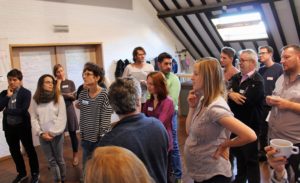The Mini Masterclass series from Future Advocacy, a London-based consultancy and think tank working at the intersection of advocacy, global affairs, and technology, presents ideas on how to maximise the impact of advocacy work.
In the latest edition below, Nick Martlew, Strategy Director at Digital Action and author of the Creative Coalitions handbook, speaks to Future Advocacy CEO Olly Buston about coalition building.
Being a coalition builder can seem to have all the glamour of a train conductor: a necessary irritant, subject to either pity or fury when it all goes wrong.
Don’t worry: this is not a desperate plea for sympathy for coalition builders. It’s — hopefully — something a little more useful than that.
Think of any campaign success you’ve seen or been involved in. I would wager good money (and as Yorkshireman I don’t say that lightly) that it wasn’t achieved by one actor alone: it was collective action that brought about change.
Now think of when collective action becomes the worst form of coalition building, sacrificing ambition and wasting time. For the people whose rights we’re fighting for, that’s unacceptable. It’s also avoidable.
So for the Future Advocacy masterclass series I pulled together three tips based in particular on my experience working with Crisis Action for the last five years, an organisation that has catalysed collective action to protect civilians from war in places like South Sudan, Syria, and Yemen. (You can dive deeper into these tips in the Creative Coalitions handbook.)
It’s about the cause, not the coalition.
Whether you’re working on the climate emergency or refugee rights or protecting local services, the coalition is a means, not an end. If you measure success by how many people you keep from opting out of a coalition, you risk diluting ambition to lowest common denominator. If you measure success by the impact you collectively achieve, then you instead seek to inspire people to join ‘opt-in coalitions’ with a shared, ambitious vision of change.
When you focus on the change, not the coalition, then you don’t keep going back to the same coalition, again and again, regardless of the opportunity or the impact. In your network, you will have the talents and connections to be more flexible, creative and effective. From Crisis Action’s experience, when our NGO partners recognised their efforts weren’t cutting through to get a peacekeeping mission to prevent genocide in Central African Republic, collectively we mobilised the country’s faith leaders. They added enormous — life-saving — power to the existing NGO coalition.
It’s not about you.
When a coalition builder is (seen to be) co-opting or instrumentalising everyone else for the glory and gold, it can slow collective action down, deter good people from joining, or skew decision making to selfish goals.
To be trusted as a convenor, you have to demonstrate that it’s not about you, that you are genuinely what Americans call ‘movement generous’. You can do this by sharing your intel, being proactive in connecting people, and being thoughtful in how you convene.
You can also follow the dictum: it is amazing what you can accomplish if you do not care who gets the credit. I’m helping set up a new organisation at the moment, Digital Action, to help protect democracy from digital threats. We’ve learnt more from Crisis Action than just to include ‘Action’ in the name: for both organisations, we don’t seek public profile for ourselves. You won’t find a campaign or press release with either of these organisations’ logos on it. As a result, we earn people’s trust: this isn’t about us, it’s about the change we’re seeking to catalyse.
Listen and lead
It is a deeply precious thing for people to pool their power and entrust you to oversee that collective. As a coalition builder, it’s your responsibility to make that collective power more ambitious, more creative, more impactful than it would otherwise be. So this is the final tip: as a coalition builder, you must listen — and lead. How to exercise both humility and audacity can be tricky, but there are plenty of lessons from Crisis Action’s experience in the Creative Coalitions handbook.
These are my tips. But change doesn’t happen in straight lines. For all of us seeking to drive change, we can only adapt and get more effective when we share feedback with one another. So please do get in touch with your own experiences, critiques, and ideas.
Check out Future Advocacy’s previous Mini Masterclass videos:
- How to create winning digital campaigns with Change.org’s UK Director Kajal Odedra
- Key elements of a strong advocacy strategy with Save the Children’s Executive Director of Policy, Advocacy and Campaigns Kirsty McNeill
- What makes a brilliant grassroots campaign with campaigner, activist and movement builder Katherine Sladden
Have thoughts to share? Get in touch with Future Advocacy on Twitter @FutureAdvocacy or by email at masterclass@futureadvocacy.org.
Top image: “Together” graffiti. Photo by Adi Goldstein on Unsplash
Categories:
collaboration



